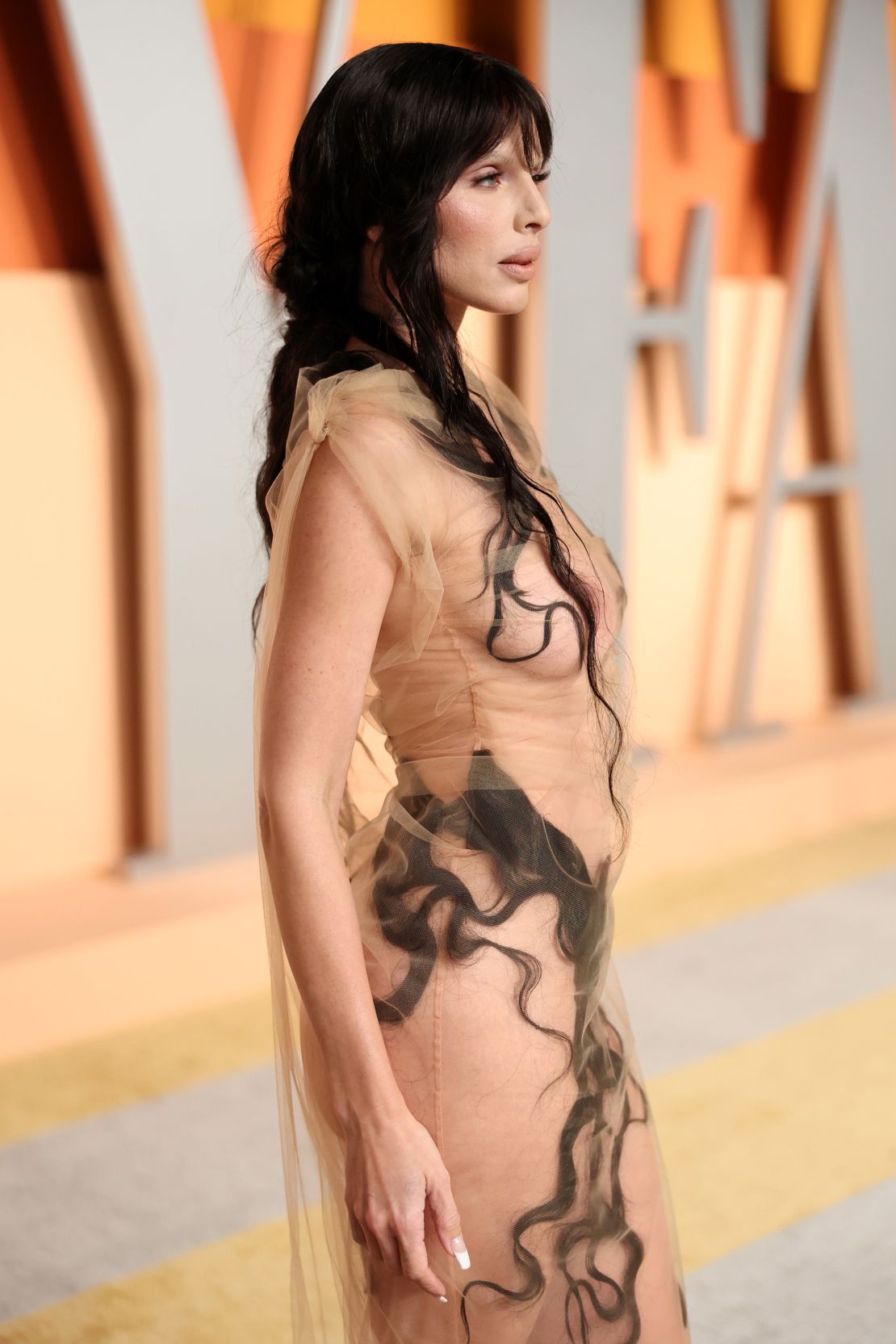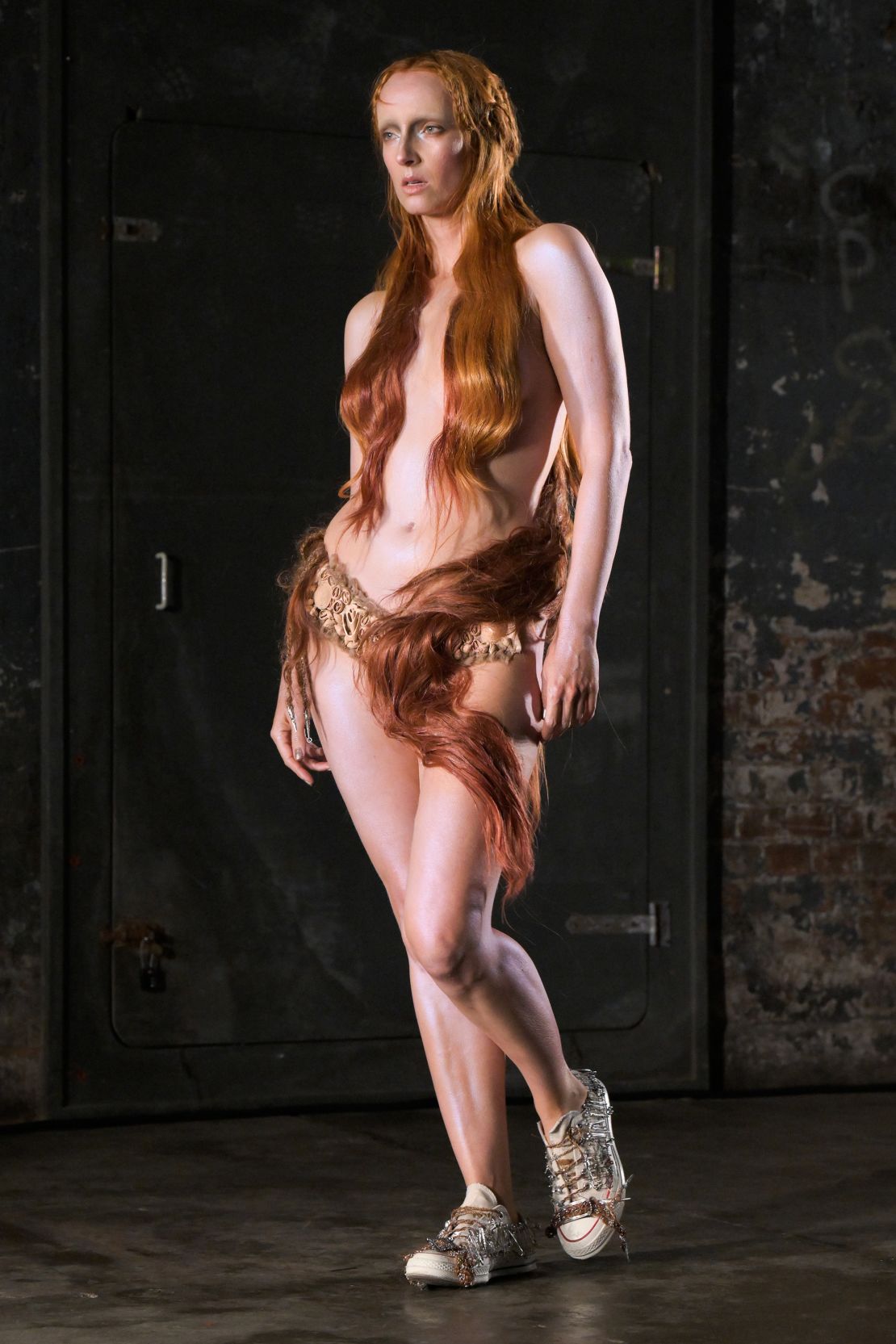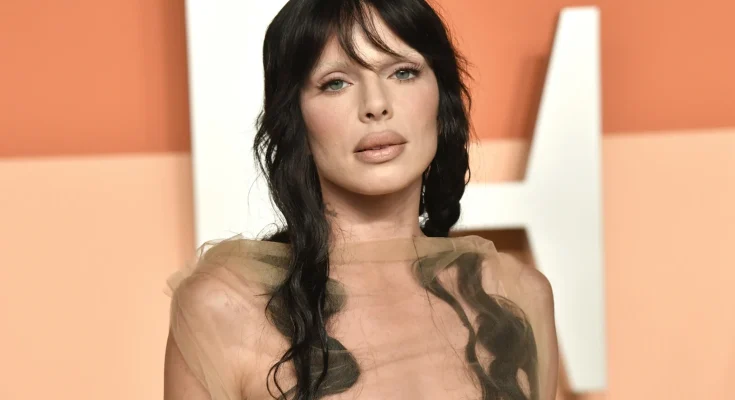Julia Fox Stuns in Hair-Adorned “Naked Dress” at Vanity Fair After-Party
After the biggest awards night of the year concluded, celebrities flocked to the Vanity Fair After-Party, where the red carpet transforms into a playground for bold, unconventional fashion statements. From crystal-studded gowns to vintage lace and avant-garde leather, the event showcased a diverse array of high-fashion risks. But among all the extravagant ensembles, one fabric choice stole the spotlight—human hair.
Never one to shy away from shocking style, Julia Fox, the reigning queen of boundary-pushing fashion, arrived in a Dilara Findikoglu naked dress, draped with strategically placed locks of dark curly hair. The look, simultaneously eerie and ethereal, made Fox appear almost mythical, as though she were a mermaid emerging from the depths, her cascading strands attempting to veil her body.
The daring dress debuted just weeks ago at London Fashion Week, where Findikoglu showcased her latest collection, “Venus from Chaos.” Featuring tattooed leather gowns, seashell-encrusted corsets, and pants that boldly expose the pubic bone, the collection is a vision of a post-apocalyptic, liberated female society, as described in Findikoglu’s show notes. The designer envisions a world where the weight of patriarchal oppression is countered by conviction and the boundless freedom of imagination.
Fox’s look was one of the most talked-about of the night, further cementing her status as fashion’s most fearless risk-taker. Love it or hate it, she knows how to make a statement—and at an event designed for the boldest of the bold, she undeniably delivered.

Julia Fox’s “Rebirth of Venus” and the Evolution of Botticelli-Inspired Fashion
Julia Fox’s daring “Rebirth of Venus” dress, designed by Dilara Findikoglu, is more than just an avant-garde fashion statement—it’s a literal reinterpretation of Sandro Botticelli’s iconic 15th-century painting, The Birth of Venus. While many designers have drawn inspiration from the masterpiece, Findikoglu’s take may be the boldest and most unconventional yet.
A Legacy of Botticelli in Fashion
Findikoglu follows a long tradition of Botticelli-inspired designs, but unlike past iterations, her vision reimagines Venus as a post-apocalyptic goddess, shrouded not in flowing fabrics but in human hair.
- 1993: Dolce & Gabbana deconstructed The Birth of Venus into fragmented puzzle pieces, printing an abstract version onto blazers, midi dresses, and bustiers.
- 2010: Alexander McQueen, in his final collection, paid homage with a gown named after the painting, though instead of Venus, it featured digitally printed saintly figures.
- 2022: Jean Paul Gaultier screen-printed the painting onto clothing, only to face legal action from Florence’s Uffizi Gallery, which claimed the label had violated Italy’s Cultural Heritage Code by using the image without authorization.
The Sheer Dress and the Changing Perception of Nudity
Fox’s look also aligns with a broader fashion movement embracing transparency and body autonomy. While sheer, nearly-nude dresses date back to the mid-20th century, today’s interpretations reflect evolving attitudes toward nudity, femininity, and self-expression.
Findikoglu’s Venus isn’t just reborn—she’s redefined. In a world where the “free the nipple” movement continues to challenge societal norms, Fox’s hair-clad gown serves as both a statement on liberation and a reimagining of historical beauty ideals.
At the Vanity Fair After-Party, Fox didn’t just wear art—she became it.

The Rise of the Sheer Dress: A Statement of Fashion, Feminism, and Controversy
At the 2025 Brit Awards, Charli XCX took to the stage in a sheer Dilara Findikoglu gown, making waves not just for her win as Artist of the Year but for the controversy her outfit sparked. Acknowledging complaints from ITV, the event’s broadcaster, regarding her visible nipples, Charli responded with a powerful rhetorical question:
“I feel like we’re in the era of Free the Nipple though, right?”
Her words echoed the ongoing feminist campaign advocating for gender equality in toplessness, challenging the persistent double standard in which male nudity is accepted while female nudity remains censored.
Navigating the Nude: The Spectrum of Sheer Fashion
While naked dresses continue to dominate red carpets, not all celebrities fully embrace the exposure. Some, like Millie Bobby Brown, opt for a more modest approach. At the Madrid premiere of Electric State, Brown wore a sheer vintage 1998 Giorgio Armani gown—previously donned by Gwyneth Paltrow—but unlike Paltrow, she paired it with nipple pasties.
Similarly, at the Vanity Fair Afterparty, both Ciara and Teyana Taylor chose sheer bodices, but their designs featured strategic coverage, offering the illusion of nudity while avoiding full transparency.
The Backlash Against Female Nudity
Despite the growing acceptance of sheer, revealing fashion, backlash persists. When Florence Pugh wore a pink tulle Valentino gown at the brand’s 2022 runway show, she was met with online criticism for exposing her chest. Addressing the controversy, she told Elle:
“My nipples were on display through a piece of fabric. It really wound people up. It’s the freedom that people are scared of; the fact I’m comfortable and happy.”
This resistance to female body autonomy underscores a larger societal discomfort—one that fashion continues to challenge.
Julia Fox: From Shock Value to Artistry
While the naked dress trend often sparks debate over its artistic merit versus shock factor, Julia Fox’s recent Vanity Fair look offers a compelling rebuttal. Unlike Bianca Censori’s Grammys ensemble, which sparked conversations about voyeurism vs. artistry, Fox’s Dilara Findikoglu dress stands apart.
Woven with strands of art history, her gown wasn’t merely provocative—it was a deliberate fashion statement, rooted in Botticelli’s “The Birth of Venus.” Fox’s look serves as a reminder that nudity in fashion isn’t just about exposure—it’s about expression, empowerment, and evolution.



